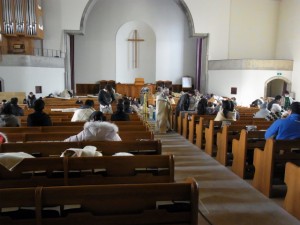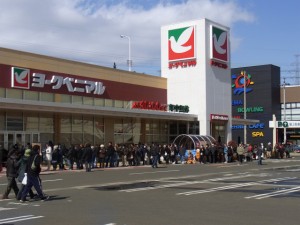The following are stories related by the Rev. Franklin Ishida, ELCA Global Mission Director for Asia – Pacific Continental Desk, from individuals affected by and responding to the disaster in Japan, as well as a update from the Rev. Hiroaki Fujii, pastor of Sendai and Tsurugaya Lutheran Churches.
———-
Stories relayed by Rev. Ishida
The Japanese networks are almost nonstop showing images of the disaster area, whether that be earthquake and tsunami related or about the damaged nuclear power plant. Some of this is news, others are story or commentary. In most instances, no voice over announcements are necessary; the stories and images speak for themselves.
A woman who is searching frantically for her husband. She looks over names at refuge points and hospitals. She tries to get to where her home was, but still can’t get close due to the debris. She walks aimlessly, her name pasted on one side of her coat and that of her husband on the other, so people can know what she’s trying to do … one more person seeking the whereabouts of a loved one.
An elderly man seeking his daughter. He looks at the descriptions of each person at the morgues. In so many cases, identifying items were washed away from the bodies, and all there is to go on are the person’s height and particular clothing. He finds one description of a embroidered design on a jacket worn by a deceased woman. He goes in to the morgue, but emerges distraught … it wasn’t her.
A man searches the web for photos taken of name lists posted at refuge points and hospitals. He looks at each one carefully and transcribes the names he finds there to a database, which he posts on the internet. A friend of a friend of a man, who had been separated from his family, sees this list and sends a text message that this man that his wife and two children are alive. Before this, he had no idea whether they were alive or not, as cell phones and other means of communication were not working properly. This was great news.
A university researcher in the area of disaster preparedness had helped plan mitigation efforts in many communities along the coast. One town built a multi-million dollar disaster/evacuation center. A school had a specific plan for evacuating children to higher ground in case of a tsunami. These plans were based on computer models for a large tsunami. The only problem was this tsunami was much greater than anything anticipated: in some places the wave was three or four times higher. People had taken refuge in the evacuation center as they had practiced, to a special room on the second floor. The tsunami overwhelmed the whole building, and even those in the “upper room” were washed away or floated up to the ceiling. One woman survived by grasping a curtain rod up by the ceiling, floating with only her face above the water. Meanwhile the children at the school had taken refuge; but they saw the waters coming up, and they all ran to even higher ground. They were safe. In all this, this researcher both grieves over the failures to prepare for a tsunami that overwhelmed all expectations; and celebrates the human will to persevere and overcome all danger.
In this disaster, there are human stories told over and over again. The words coming from the survivors, the rescuers, the caregivers, and others. These are enough to make this all so real.
———-
Update from Rev. Fujii from Sun, March 20
Today, eleven people attended worship.
Several members had already told me they could not attend because of there being no gas.
We are thankful for everyone around the country for their special prayers for victims of the disaster. We prayed this during worship. We also announced that a group will be coming on the 23rd from the disaster task force.
(Oh, we just had another aftershock.)
In response to the news that task force people are coming, there are differing opinions on this. Some of positive, while others are less so … even though they are victims of a major disaster, they don’t want all the attention.
Some members want as many propane tanks [used for table top cooking stoves] as possible. If you can bring these, it would be very helpful. We also need toilet paper.
While our lives are slowly getting back to normal, there are still many inconveniences.
Just yesterday, I stood in line for over an hour just to get two packages of instant noodles and soup.
At today’s worship, some members brought rice and packaged food. We are grateful.
————-
Gifts to ELCA International Disaster Response allow the church to respond globally in times of need. Donate now.



